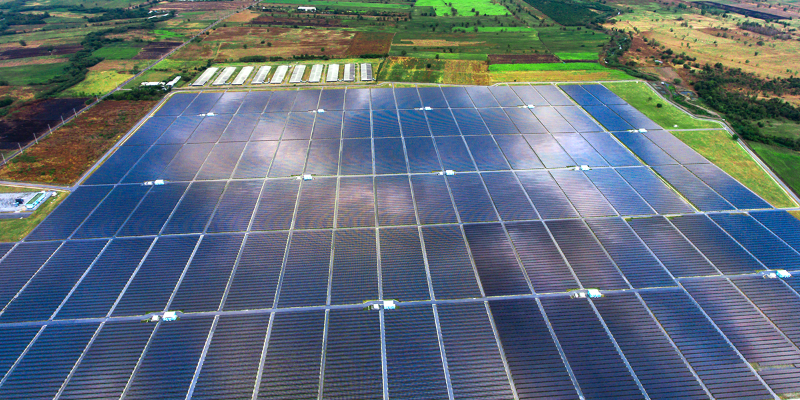Big Rivers Lowers Costs, Boosts Supply Diversity with Solar

Last year, western Kentucky-based generation and transmission (G&T) system Big Rivers Electric Corporation signed long-term power purchase agreements (PPAs) for three new solar projects totaling 260 MW. The large commitment to solar was upsized from Big Rivers’ original plans due to favorable pricing and is expected to result in a trifecta of benefits for the G&T and its members, including lower power costs, greater fuel diversification and a further greening of Big Rivers’ power supply portfolio.
“Initially, we wanted to purchase 100 to 150 MW of solar power to meet our obligation to an industrial member and provide some renewable energy to our three distribution cooperative member-owners—Jackson Purchase Energy Cooperative, Kenergy and Meade County Rural Electric Cooperative Corporation,” Big Rivers President and CEO Bob Berry said. “After receiving responses to our initial RFP, the prices came in quite favorably, so we added the additional 160 MW to diversify our portfolio.”
G&T Expects Cheaper Financing Costs with Greater Portfolio Diversification
Part of Big Rivers’ decision-making process involved expectations of cheaper financing costs in the future due to portfolio diversification from the solar purchase.
“Credit rating agencies are starting to emphasize environmental, social and governance (ESG) criteria. In order to have access to the best financing rates, Big Rivers needed to rebalance its supply portfolio and limit our dependence on any one resource,” Berry explained.
In 2013, 86 percent of Big Rivers’ capacity portfolio consisted of coal generation. By 2024, the amount is expected to fall to 32 percent.
“After combining the solar purchases with our 178 MW of hydro allocation from the Southeastern Power Administration, 34 percent of our capacity portfolio will be carbon-free. The balance will be about equally split between coal and natural gas generation. The overall effect is to reduce our carbon footprint while building an ‘all-of-the-above’ generation portfolio that reduces our members’ exposure to any one fuel,” Berry continued.
The Solar Power Projects Help Meet C&I Member’s Renewable Energy Need
The total amount of electricity produced by the three new solar projects—to be sited in the service territories of each of Big Rivers’ member-owners—will be enough to power about 40,000 homes annually.
The 20-year solar PPAs will also help Big Rivers satisfy the renewable energy component of a 2019 power supply deal with Nucor Corporation for its new, $1.35 billion steel plate manufacturing plant in Brandenburg, Kentucky, where Nucor expects to add approximately 400 full-time jobs.
“The competition for the Nucor load was very intense among several potential sites in the Midwest,” Berry said. “Big Rivers was looking for a way to offer a low, long-term fixed price without exposing our members to significant market risk. The 20-year pricing that we had been hearing from solar developers seemed a perfect fit for part of the Nucor load, and we were able to assemble a pricing structure that combined a new solar development with our existing tariff rates in a way that met Nucor’s expectations.”
Economic impact studies estimate that the 400 new Nucor jobs will result in about 3,000 total jobs and $190 million in annual wages for Kentucky, including both direct and indirect benefits.
Big Rivers works closely with its member cooperatives on economic development opportunities, like the Nucor plant. Recently, the G&T has noticed an uptick in the number of companies looking for renewable energy to power part of their operations.
Balanced Approach to Power Generation is Good for Economic Development and Lowers Risk
“We work very closely with our member-owners on each economic development project that comes their way. We are happy to include information regarding our power portfolio, as an increasing number of economic development projects inquire about renewable energy being part of the equation,” Berry said. “As a practical matter, more companies today are looking for balanced portfolios with less exposure to some of the perceived risks associated with coal. Cost to our members will always drive our decisions, and coal is still an economic source of energy. We think the work we have done over the past eight years to rebalance our portfolio will make some of the already attractive sites in our footprint even more appealing to economic development candidates.”
Big Rivers is not currently planning any additional renewable projects, but does plan to keep its generation portfolio balanced as it grows. This diversification of resources is expected to benefit the G&T, particularly as interest in carbon-free generation continues to expand.
“Diversification of the generation portfolio surprisingly establishes Big Rivers as an industry leader in decarbonizing, already surpassing the long-term goals of many generators. Big Rivers has reduced carbon emissions during the past decade by 57 percent and a significantly greater reduction is planned by 2025,” Berry said.
Published Feb. 22, 2021, in CFC Solutions News Bulletin.